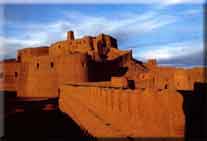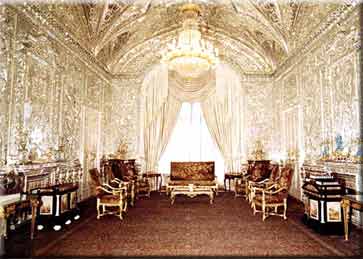|
History
The
plateau of Iran is amongst the oldest civilization center of antic era
in Asia, and has Migration of Aryan clans to the plateau of Iran began since 2nd millennium BC. Out of these tribes, parthians dwelled in Khorasan, Medes in the west, and Parsees resided in the south of Iran. The Median Empire rose in Hekmataneh (Ekbatan), present Hamedan. The Achaemenidae established the first great Iranian Empire after defeating the Medians and conquest of their capital. The limits of the Achaemenian territory in the reign of Dariush I (522-485 BC.) extended from the plain of Sand River in the east to the borders of Greece at the west. Passargad and Persepolis are the vestiges of this period and are amongst the most important historical places as well as the significant tourism attractions of Iran. Thousands of tourists visit these places annually.
After the decline of the Achaemenian dynasty, and destruction of Persepolis by Alexander, his successors (solukis) dominated over Iran for a short time. During this period the interaction of Iranian and Hellenic cultures happened. Around the year 250 BC. The parthions, which were one of Aryan tribes as well as horse riders, advanced from Khorasan towards the west and southwest and founded their empire over Iran plateau in Teesfoon. This empire sustained till the year 224 AD. The Sassanides, after defeating the last Parthian king in 225 AD. founded a new empire, which lasted till mid 7th century AD. The ancient period of Iran (Persia), regarding its political, social, and cultural characteristics, is one of the most magnificent epochs of Iranian history. Out of this era, there have remained so many cultural heritage and historical buildings in Persepolis, Passargad, susa (shoosh). Shooshtar, Hamedan, Marvdash t(Naghsh-e-Rostam), Taghbostan, Sarvestan, and Nayshabour which are worth-seeing.
Emergence
and influence of Islam in Iran happened in early 7th century AD, after
the decline of Sassanide Empire since then new era began in the history
of Iran, which caused severe fundamental evolution in social, political,
religious, governmental, and public conditions of the country. Meanwhile, social movements of Tobacco, Constitutional Revolution, Forest Uprising, Sheik Mohammed khiabani revolt, and… happened. In Pahlavi time, Oil Industry Nationalization Movement intrigued the movement of June 5th 1963 and other autonomous movements that gave rise to the Islamic Revolution under the leadership of Imam Khomaini in 1979.
|
|||||||||||||||||||||||||||||||||||||
|
-Achaemenian -Solookian -Parthian -Sassanians -Attack of Arabs against Iran -Omavian and Abbasian -Saffarian -Samanian -Al Bouyeh -Ghaznavian -Saljooghian -Kharazmshahian -Attack of Mongols to Iran -Ilkhanian -Mozaffarian -Taymoorian -Turkamanan -Safavian(Safavid) -Afsharian -Zandian -Ghajarieh -pahlavi -Islamic Revolution |
533-330 BC 330-247 BC 247 BC –224 AD 224-651 AD 645 AD 749-932 AD 866-903 AD 819-999 AD 945-1055 AD 977-1186 AD 1038-1194 AD 1077-1231 AD 1220 AD 1256-1353 AD 1314-1393 AD 1370-1506 AD 1380-1468 AD 1501-1732 AD 1734-1796 AD 1750-1794 AD 1779-1924 AD 1924-1979 AD 1979 AD |
*

 an important place in archeology science. The history
of settlement in the plateau of Iran from new Stone Age till migration
of Aryans is not yet very clear. But there are reliable evidences, which
indicate that Iran has been inhabited since a very long time ago.
Settlement centers have emerged close to water resources like springs
and rivers or totally close to Alborz and Zagross mountains. The most
important centers of this kind are: Tappeh (hill) Sialk in kashan,
Tappeh Hesar in Damghan, Torang Tappeh in Gorgan. Tappeh Hasanloo in
Azerbaijan, Marlik Tappeh in Roodbar, and Sosa (Soosh) in Khuzestan. In
archeological excavations in these civilization centers, some vestiges
have been discovered the antiquity of which dates back to 5th millennium
BC.
an important place in archeology science. The history
of settlement in the plateau of Iran from new Stone Age till migration
of Aryans is not yet very clear. But there are reliable evidences, which
indicate that Iran has been inhabited since a very long time ago.
Settlement centers have emerged close to water resources like springs
and rivers or totally close to Alborz and Zagross mountains. The most
important centers of this kind are: Tappeh (hill) Sialk in kashan,
Tappeh Hesar in Damghan, Torang Tappeh in Gorgan. Tappeh Hasanloo in
Azerbaijan, Marlik Tappeh in Roodbar, and Sosa (Soosh) in Khuzestan. In
archeological excavations in these civilization centers, some vestiges
have been discovered the antiquity of which dates back to 5th millennium
BC.
 Iranians,
who were very disappointed with existing social and economic inequality
in the time of sassanides, accepted Islam rapidly and tried to expand it
and enrich its cultural magnanimity. In spite of accepting Islam,
Iranians never covered up their opposition against dominance of Omavi
and Abbasi Caliphs and their tyrannies and founded many autonomous
movements to confront them. On the other hands, caliphs, for
neutralizing and suppressing these Iranian movements, which were based
on partisanship of the Islam Prophet’s family and establishment of a
government on the basis of Imamate, tried to support non-Iranian forces.
Due to continuity of these wars of attrition among local governors,
their power was exhausted, so the ground for dominance of stranger
tribes of central Asia, like Saljooghi Turks, Mongols, and Taymoorians,
was brought about. In Safavid time, the second great Iranian Empire was
founded and Shiite religion, disciples of which were seriously limited
till then, was formalized. The dynamic nature of Shiite religion and its
political and social commitments firmly safeguarded the independence and
national identity of Iran against Ottomans` assaults. Iran, as a new
political and religious power, could once again hoist the flag of
resistance against a very powerful empire that was the claimant of
supermacy of Islamic world. With the decline of safavid, Afsharieh and
then zandieh took the throne. After Zandieh government, the time of
Ghajarieh began during which the influence of foreign powers of England
and Russia in internal affairs of Iran expanded.
Iranians,
who were very disappointed with existing social and economic inequality
in the time of sassanides, accepted Islam rapidly and tried to expand it
and enrich its cultural magnanimity. In spite of accepting Islam,
Iranians never covered up their opposition against dominance of Omavi
and Abbasi Caliphs and their tyrannies and founded many autonomous
movements to confront them. On the other hands, caliphs, for
neutralizing and suppressing these Iranian movements, which were based
on partisanship of the Islam Prophet’s family and establishment of a
government on the basis of Imamate, tried to support non-Iranian forces.
Due to continuity of these wars of attrition among local governors,
their power was exhausted, so the ground for dominance of stranger
tribes of central Asia, like Saljooghi Turks, Mongols, and Taymoorians,
was brought about. In Safavid time, the second great Iranian Empire was
founded and Shiite religion, disciples of which were seriously limited
till then, was formalized. The dynamic nature of Shiite religion and its
political and social commitments firmly safeguarded the independence and
national identity of Iran against Ottomans` assaults. Iran, as a new
political and religious power, could once again hoist the flag of
resistance against a very powerful empire that was the claimant of
supermacy of Islamic world. With the decline of safavid, Afsharieh and
then zandieh took the throne. After Zandieh government, the time of
Ghajarieh began during which the influence of foreign powers of England
and Russia in internal affairs of Iran expanded.